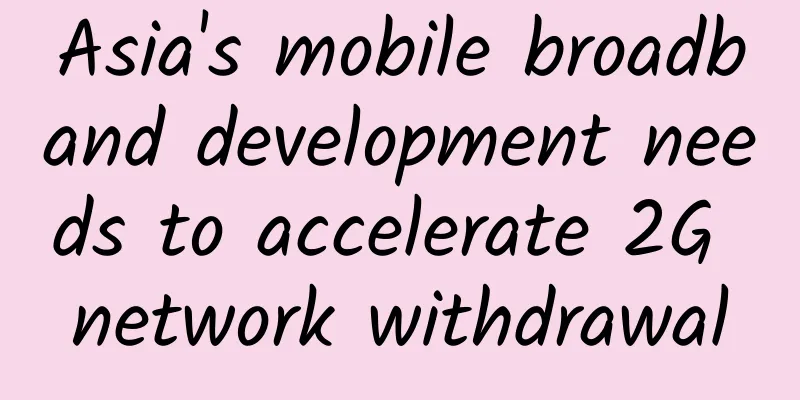Asia's mobile broadband development needs to accelerate 2G network withdrawal

|
In Ovum's latest World Cellular Information Service Subscriber Forecast report, the forecast for Asia highlights a major shift towards mobile broadband (MBB) in 2016, and indicates that the decline in 2G subscriptions will accelerate from 2017. Charles Moon, Ovum's Asia practice leader, said that mobile broadband has become the mainstream mobile technology in Asia in 2016. The growth rate of mobile broadband (LTE/W-CDMA/TD-SCDMA) users in Asia was 28% last year, accounting for more than half of all mobile users. By the end of last year, the penetration rate reached 53% and the number of users reached 3.9 billion. Source: World Cellular Information Service Growth is mainly driven by LTE, with 9 out of 10 net new mobile broadband subscriptions last year. Asia’s most populous countries, China, India and Indonesia, are the biggest drivers of this segment as young urban consumers tend to connect to 4G networks using new smartphones. Ovum said that the development trend of mobile technology has shifted to mobile broadband, and 2G users will decline rapidly from 2017, from half of all mobile connections at the end of 2016 to only 13% in 2021. There are still more than 500 million 2G users, and most of the population in many emerging markets will continue to use 2G services. However, in two countries in Asia, China and Indonesia, the proportion of 2G users will drop below 10% by 2021. By then, mobile broadband penetration in both countries will reach 100% or even higher, which may stimulate regulators to approve the shutdown of 2G networks earlier, allowing spectrum to be redeployed for data services. Source: World Cellular Information Service This is already happening in two of Asia’s most advanced markets, Australia and Singapore, which will shut down their 2G networks this year and refarming spectrum to boost 3G/4G network capacity. Operators in developing markets, particularly Indonesia, Myanmar, Vietnam, Sri Lanka and China, can look to Australia and Singapore as examples for their 2G rollouts. Accelerate the withdrawal of 2G networks to support the rapid growth of data Although the decline of 2G is inevitable, emerging markets may be relatively strict in implementing 2G network withdrawal, and old technologies remain sticky in these countries, resulting in a slower migration to the technology. Operators can accelerate migration by appealing to the price sensitivity of late adopters. Selling 3G feature phones by offering attractive services and trade-in offers is an effective way to encourage 2G users to upgrade. Much of the cost of a new device can be offset by operators offering trade-in offers for old 2G devices. In Singapore, users who purchase a new 3G phone can enjoy a prepaid offer of 30 Singapore dollars for local talk time. Using offers can effectively reduce the total cost of ownership, especially in emerging markets such as India, where 3G feature phones are only a few dollars more expensive than 2G devices. It may be more difficult for 2G users to upgrade to smartphones due to higher prices and limited familiarity with smartphones. Cheap smartphones are still more than five times the price of 2G devices, and the additional data costs may also affect this small market of generally low-income rural users (at least initially). In addition, battery life is the second most important factor for Indian consumers when choosing a phone after price, which may continue to hinder smartphone penetration in the medium term, causing some users to stick with feature phones. Finally, Ovum said that the growth of mobile broadband in emerging Asian markets has forced operators to accelerate the withdrawal of 2G networks. Australia and Singapore have actually become pioneers. |
<<: Why is there no movement in China for the popular wireless mesh network?
>>: Aryaka wins the 2016 Global Most Influential SD-WAN Solution Award
Recommend
The Advancement of WiFi 6 Wireless Router Market Report for the First Half of 2020
In the first half of 2020, affected by the epidem...
Five strategies for WAN data acceleration
Flash storage, hyperconverged infrastructure, Lin...
FCC votes to approve new round of 5G auction: once reserved for the US military
The Federal Communications Commission (FCC) voted...
What exactly is HTTP3 that international companies such as Google are beginning to support?
There has been a lot of news about HTTP/3 in rece...
A 100% timeout murder caused by maxing out the bandwidth!
[[421757]] Verse: Do not advise others to do good...
DiyVM: Japan Osaka/US Los Angeles/Hong Kong Shatin CN2 line 2G memory VPS monthly payment starts from 50 yuan
DiyVM has recently made major changes to the webs...
Lessons from data center outages: Focus on infrastructure
The majority of downtime incidents over the past ...
Talk about IPv6 and Happy Eyeballs
[[256713]] Let's look at a picture first. Fro...
Millimeter wave: a hurdle that 5G deployment cannot overcome
5G is seen by the industry as a revolutionary wir...
5G applications drive cellular IoT module market growth
Global cellular IoT module shipments are expected...
CMIVPS: Hong Kong large bandwidth/US AS4837 line VPS host monthly payment 20% off/annual payment 30% off
CMIVPS is a Chinese hosting company founded in 20...
Why does TCP use three-way handshake? Can't two or four-way handshakes work?
The TCP protocol needs three handshakes to establ...
A pitfall when using HTTP Client that you must avoid
Preface As software developers, we know that seem...
HostingViet: Vietnam VPS monthly payment starts from 28 yuan, 2GB memory/20G SSD disk/150M unlimited traffic
HostingViet is a local Vietnamese host establishe...
What is Zigbee and why is it important for your smart home?
Zigbee is a widely used smart home protocol that’...









